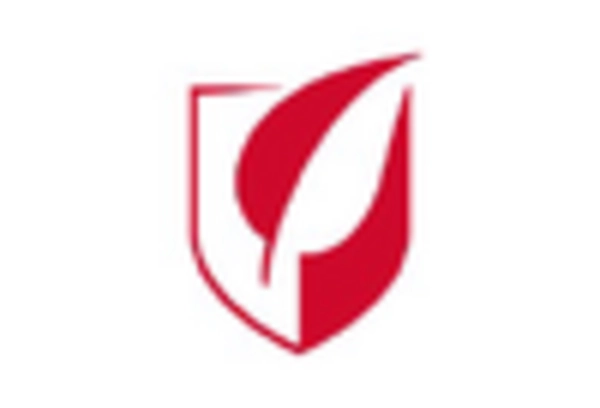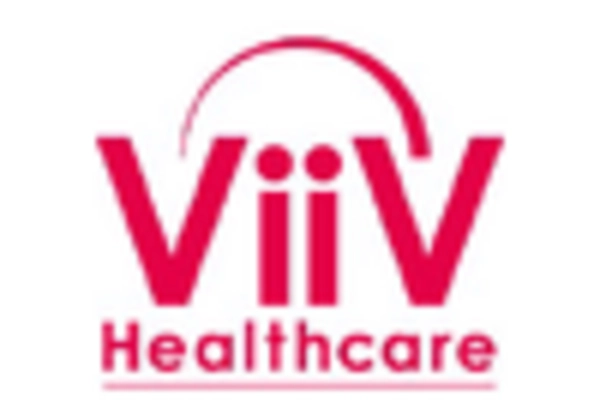Rising Prevalence of HIV
The increasing prevalence of HIV in the US is a critical driver for the HIV Drugs Market. According to the Centers for Disease Control and Prevention (CDC), approximately 1.2 million people in the US are living with HIV, with around 38,000 new infections reported annually. This persistent prevalence necessitates ongoing demand for effective antiretroviral therapies and other treatment options. The growing number of individuals requiring treatment fuels the market, as healthcare providers seek to offer the latest advancements in HIV medications. Furthermore, the rising awareness and testing initiatives contribute to early diagnosis, which is essential for effective management of the disease. As more individuals are diagnosed and enter treatment, the hiv drugs market is likely to experience sustained growth, driven by the need for innovative and effective therapeutic solutions.
Advancements in Drug Development
Innovations in drug development are significantly impacting the hiv drugs market. The introduction of novel antiretroviral therapies, including long-acting injectables and combination therapies, has transformed treatment paradigms. Recent advancements have led to the development of drugs that not only improve adherence but also enhance the quality of life for patients. For instance, the FDA has approved several new medications that target HIV with greater efficacy and fewer side effects. The market is projected to grow as pharmaceutical companies invest heavily in research and development, aiming to bring forth next-generation therapies. This focus on innovation is expected to drive competition among manufacturers, ultimately benefiting patients with more effective treatment options. The ongoing evolution in drug development is a key factor that shapes the dynamics of the hiv drugs market.
Increased Focus on Mental Health
The recognition of mental health as a crucial component of overall health is influencing the hiv drugs market. Individuals living with HIV often face mental health challenges, including depression and anxiety, which can impact treatment adherence and health outcomes. As healthcare providers become more aware of the interplay between mental health and HIV, there is a growing emphasis on integrated care models that address both physical and mental health needs. This holistic approach encourages the development of treatment plans that incorporate mental health support alongside antiretroviral therapy. Consequently, pharmaceutical companies are exploring options that not only target the virus but also consider the psychological well-being of patients. The increased focus on mental health is likely to shape the future landscape of the hiv drugs market, promoting comprehensive care strategies.
Government Initiatives and Funding
Government initiatives and funding play a pivotal role in shaping the hiv drugs market. The US government has committed substantial resources to combat HIV through programs such as the Ryan White HIV/AIDS Program, which provides comprehensive care and treatment for individuals living with HIV. In recent years, federal funding for HIV prevention and treatment has increased, reflecting a commitment to reducing new infections and improving health outcomes. This financial support enables healthcare providers to access the latest medications and treatment options, thereby enhancing patient care. Additionally, public health campaigns aimed at increasing awareness and reducing stigma surrounding HIV contribute to higher testing rates and treatment uptake. As government efforts continue to evolve, they are likely to have a lasting impact on the hiv drugs market, fostering an environment conducive to growth and innovation.
Growing Demand for Personalized Medicine
The trend towards personalized medicine is emerging as a significant driver in the hiv drugs market. Tailoring treatment regimens to individual patient profiles, including genetic factors and drug resistance patterns, enhances the effectiveness of HIV therapies. As healthcare providers increasingly adopt precision medicine approaches, the demand for specialized testing and targeted therapies is likely to rise. This shift not only improves treatment outcomes but also aligns with the broader trend of individualized healthcare. Pharmaceutical companies are responding by developing drugs that cater to specific patient needs, thereby expanding their market reach. The integration of personalized medicine into HIV treatment protocols may lead to more efficient use of resources and improved patient adherence, ultimately contributing to the growth of the hiv drugs market.

















Leave a Comment